| THE PICTURE FRAME |
 |
| The history of the picture frame is as rich and detailed as the frames themselves. From painting frames onto wood around the image to entire corporations dedicated to designing new styles, the framing industry has grown and changed since the fourteenth century.
Today, there seems to be a general shift from inventing new frames to inventing entirely new ways to display art without the use of the traditional frame. Floating wall mounts and stick-on decals have entered the market, though some decorators still prefer the classic look of the tangible border.
From Renaissance opulence to the stark simplicity of modern decor, the progress of art display is an excellent facet from which to view the social and visual changes that are undergoing our society all the time.
|
SUMMARY
| History of Frames |
American Frames |
Modern Frames |
Going Frameless |
- Medival
- Renaissance
- Baroque
- France and England
- Napoleon
|
- Whistler
- Standford White
- Twachtman
- Prendergast
- Federal and Empire
|
- Natural rustic
- Matte black and white
- Simple profiles and bold colors
- Canvas frames
|
- Plexi face mounts
- Dry mounting
- Canvas and fabrics
- Plaque mounts
|
|
| HISTORY OF THE PICTURE FRAME
|
 |
MEDIEVAL
The concept of a frame was practiced in Egyptian and Greek art, by simply painting a bordering design around the image on the same level and substrate as the artwork itself. This was ideal for frescos and wall paintings, for it served as an obvious divider between the image and the rest of the room's decor.
It wasn't until the 12th century or so that actual separation of frame and artwork became popular. In Medieval times, many paintings were created on wood. A slight drop would be carved out to create a ledge around the section to be painted. A frame would then be painted or carved into this ledge.
Today, a frame like this would not be available unless made by special order at an artist's request.
RENAISSANCE
During the Italian Renaissance of the 14th to 16th centuries, frame styles were closely tied to architectural styles, intended to fit flawlessly among the ornate window and door frames of the period. Compared to most other times, the Renaissance saw the most varience in frame designs. Gothic and classical architecture were drawn from, and recreated in types of wood that best suited their use. Craftsmen tended to use less expensive woods like poplar and pine for the "secondary" sections of the frame, while basswood was used for fine details because of its ability to support complex designs.
- Tabernacle Frame
Inspired by the frames of Byzantine icons, which were often carved from the same panel as the painting, Tabernacle frames were intended for devotion and placed within church altars, but were constructed separately and indicate the movement toward frames made to contain art, not as a permanent part of the art. These frames mimicked the alter in which they were placed, often having ornate pillars and lintels.
- Cassetta Frame
Created to contain secular paintings as opposed to the religious depictions of the Tabernacle (mythological allegories or portraiture), the Cassetta frame (also called an entablature frame) was generally simpler, but had a very wide array of styles. It was essentially a simplification of the tabernacle which abandoned the stylized columns for a continuous border. By the 16th century, cassetta styles were so diverse they could be visibly identified by region. Primary regions included Tuscany, Venice, and Bologna.
- Gallery Frame
Identified as a gallery frame for lack of an official name, these frames fall somewhere between cassetta and tabernacle frames. While all sides need not be identical, the variation is not as distinct as a tabernacle frame. The prevalent style from then on, these frames often borrow from classical architectural design or the natural world. The Venetian Sansovino frame is one of the best known, and features overlapping scroll designs, often with a rustic look. In Tuscany, the circular Tondo frame style was popular.
In later periods, many tabernacle frames were replaced by gallery frames in the contemporary style.
BAROQUE
Primarily in Italy beginning around 1600, the Baroque style incorporated many facets of design and so, not surprisingly, affected the picture framing industry as well. The style was identified by exaggerated motion and grandeur, and the frames often features large scroll and leaf details that swept elegantly around the frame in intricate, symmetrical designs that were nearly three dimensional.
THE KINGS
Throughout the reign of four French kings, picture frame styles changed considerably.
- Louis the 13th: The first officially "French" picture frame style, though it still borrowed heavily from Italian design. Most had a convex profile decorated with foliage such as laurel and oak leaves. These carvings were very shallow, giving the frame a relatively flat appearance.
- Louis the 14th: Identified as "furniture design" styles, predominant in the 17th century. Whenever a new furniture style was developed, a picture frame was likely created to match. Clusters of more ornate decoration were found in the corners and centers of these frames, breaking up the simpler design on the rest of the face.
- Louis the 15th: During this period, picture frames faced a shift from primarily artist-designed pieces inspired by exterior architecture, to interior and furniture design imitations. Rococo was a popular 18th century artistic movement, and this flamboyant and ornate style appeared on many frames. Features included asymmetrical designs and organic elements such as animals and shells. During this and the next king's reign, the Trumeau overmantel style was popular, and consisted of an intricate design confined to the top horizontal arm of the frame.
- Louis the 16th: Influenced in part by the preferences of Marie Antoinette, this style featured a simpler design, with smaller detailed carvings and a departure from the sprawling frames of the past. The motif tended to be continuous, with no unique corner or central designs. This new style was considered the first phase of Neo-Classical designs.
REVOLUTION AND NAPOELON
The French Revolution (1789-1799) effectively halted even the simplest design elements. Frames were constructed with a simple scoop profile with no ornamentation whatsoever.
In 1799, at the end of the revolution, Napoleon Bonaparte came into power and resurrected the industry. In fact, he ordered many of the frames displaying artworks in the Louvre to be replaced. To keep up with the flood of orders, the picture frame length moulding that are used today become the primary material, allowing the framers to simply cut and join pre-carved lengths of wood rather than having to carve each frame individually.
ENGLISH FRAME STYLES
Though behind their European counterparts in this area, the United Kingdom did have its own picture frame styles, originating in the late 18th century. The Chippendale, and Kent frames incorporated elements of French and Asian design. Considered one of the best wood carvers of the time, Grinling Gibbons produced elegant frames with organic flora and cherubic elements.
|
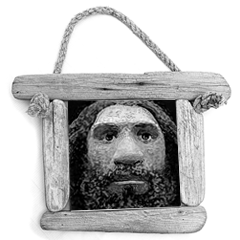
The First Frame!!!
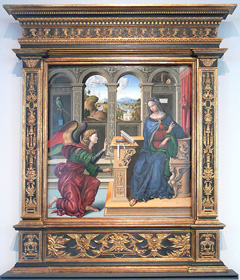
An Italian Renaissance tabernacle frame
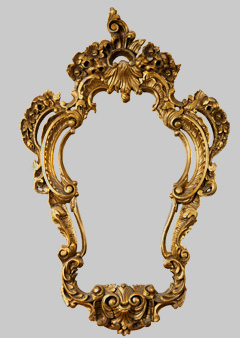
A Baroque picture frame
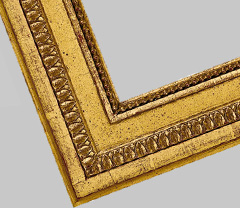
A Louis the 16th-style frame

An English Chippendale frame
|
| AMERICAN FRAME STYLES
|
 |
|
In the early years of America, domestic picture frames tended to be quite plain, with the exception being those influenced by European design. As more and more skilled artists and craftsmen began relocating to the United States, the nation's decor styles began to expand and evolve.
The artist James Whistler was not only an accomplished and sought after painter, but a frame designer as well (primarily for his own artwork). While his designs lacked the ornate details of earlier European frames, they had an appealing simplicity that spoke to the painting style of the day.
Other artists and designers creating frames in America during the 19th and early 20th century included impressionist landscape painter John Henry Twachtman, and Stanford White, the architect who designed the Madison Square Garden arena, and Charles Prendergast, a post-impressionist artist. Popular frame styles designed in the U.S. also included the Federal frame and the Empire Frame.
|
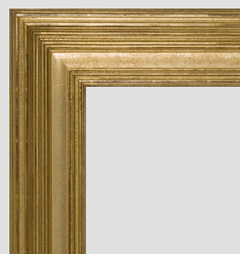
An early 20th century Whistler frame
|
| MODERN PICTURE FRAMES
|
 |
|
With the advent of modern architectural and interior design styles, picture framing was one of the many aspects of decor that was simplified, with plenty of bold, straight lines, angles, and a general lack of detailed carving. This could have been due, in part, to the popularity of framing photographs instead of paintings and other more traditional forms of art.
Though many collectors and decorators still seek out the ornate frames of the past centuries to suit "classically" decorated rooms and to outfit paintings and prints from those periods, the trend has certainly turned toward a plainer style. Color, instead, seems to have been adopted to maintain what might have been lost by the lack of flower leaf designs.
Modern picture frames come in a vast array of styles as well as color, from bold reverse slope profiles to soft curves and ridges. With this simplification in decoration also came a shift toward multi-opening frames that allow the decorator to showcase multiple images within a single frame. Non-traditional shapes have also become popular, with heart, oval, and even many-sized geometric or organic shapes available from many mass manufacturers.
Where in past generations, canvas paintings would be framed similarly to other media, modern framing also offers a new, minimalist solution to this ever-popular style of art.
Canvas Floater frames are created to avoid obscuring any of the canvas painting or print, even the small portion of the edge that a traditional frame hides. These frames overlap the back of the canvas instead of the front, allowing for a small gap between the edge of the canvas and the narrow face of the frame and creating a pleasing shadow.
Floater frames come in many different finishes and colors, though most of them remain quite simple, intended to serve as a distinction between art and wall, not to distract from the artwork in any way.
|
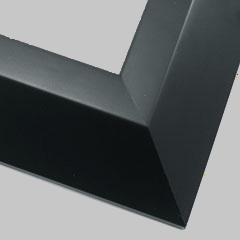
A simple, reverse slope black matte frame
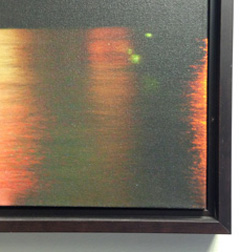
A modern canvas floater frame
|
| THE MOVE TO FRAMELESS
|
 |
|
Though picture frames, both ornamented and modern, are still purchased by artists and decorators for personal and corporate displays, there has also been a shift in recent years to a style even more simplified than plain matte black.
Frameless artworks are gaining in popularity for a number of reasons. Often, such styles are less expensive than the traditional framing of a piece. They can be lighter and therefore easier to hang and transport, and also allow the purchaser to envision the piece in their own home without worrying that the frame does not fit their decor.
FRAMELES "FRAMES"
The art is placed between two panes of glass or plexiglass (or one pane and a board backing) and held in place by clips or wires that result in a "floating" appearance. Some smaller frames are even equipped with small magnets in the corners which hold the glazing and backing together with the image trapped securely in place. These frames make changing the artwork a simple task.
GLAZING ALTERNATIVES
For those who want to forgo the traditional glass or plexiglass glazing entirely, alternate mounting options are now offered by some framers and printing businesses.
Plexi Face Mounts
This contemporary art display style is popular with photographs, but looks great with art prints as well. The print is mounted, using heat-activated adhesive, to a sheet of aluminium di-bond. A pane of high quality acrylic glass is then affixed to the front. This direct contact of print and plexiglass creates a three-dimensional effect and can increase saturation of the image. For more information, visit our page all about plexi face mounting.
Dry Mounting
Using a method similar to the plexi face mounts, a print can be attached to virtually any rigid surface, from wood to foam board to plastic (Sintra). Once affixed to the backing, the print can be left as-is for a completely unaltered look, or can be topped with resin, which gives a varnish-like shine and can enhance the print much like the plexiglass in a face mount. Read more about the wonders of resin in our article about epoxy resin coatings.
Plaque mounts are another popular and less expensive option to a frame, and are created by laminating a printed image on a fiberboard backing. They are durable and the bevelled edge can be painted any color to create a frame-like board without distractnig from the image.
SUBSTRATE ALTERNATIVES
Where cloth - namely canvas - was previously used only for creating original artworks, advancements in printing have made canvas into suitable substrate for every print, from photography to charcoal sketches or pencil drawings.
A gallery wrapped canvas doesn't even need one of the floater frames mentioned above. Wrapped so as to hide all hardware from the front and sides, the stretched canvas can simply be hung on the wall as is, so a simple "framing" solution to a beautiful piece of art.
Peel-and-stick printable fabrics have also become popular in recent years. Able to be adhered and removed multiple times to windows, walls, and even ceilings, these fabrics offer a canvas-like texture combined with the versatility of a vinyl decal. At KeenART Media, we offer PhotoTex - a high quality yet thin, tear- and fade-resistant material that produces vibrant art.
|

Plexi face mount
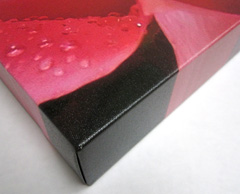
Gallery wrapped canvas

Plaque mount
|
|
| THE FUTURE OF ART
|
 |
|
Holograms may seem a thing of science fiction novels and Star Trek, but the decorative and design possibilities they offer may be nearer than we think.
One new tool supporting this theory is the Hololens by Microsoft. The Hololens allows the wearer to interact with their digital environment in a three dimentional, hands on way. This is useful for everything from city planning to toy manufacture, but in the world of home decor, it will be a great way to test out interior and exterior changes to the home or office before actually making them. Imagine being able to hang a picture in three different locations without putting any holes in the wall.
Products like Hololens might be the future of design and decor, but in the end the physical, framed artwork will still grace the walls for all to see.
Watch the Microsoft Hololens promotional video here.
|

|
|
Picture frames have a vast and fascinating history that follows the fashion and stylistic trends of every period since medieval times. Today, many manufacturers are still inspired by these centuries-old frames, and modernized versions of most designs can be found, complete with antiquing for a truly authentic look.
Although demand for frameless display options is growing, traditional picture frames still have a place in decor and are likely to continue as a popular choice for many years to come.
If you have any questions about our products or services, please do not hesitate to contact us. Our knowledgeable staff are always happy to help.
|
|
© 2002-2025 - KeenART Media Ltd.
|
|
| |
|
